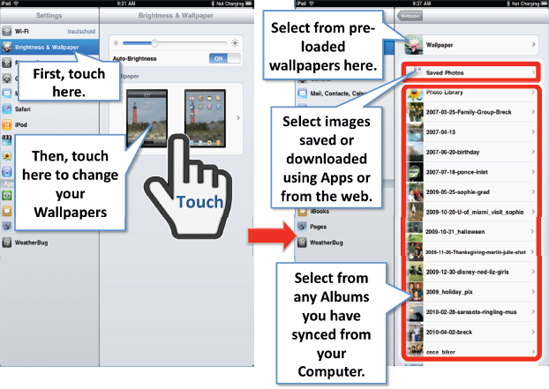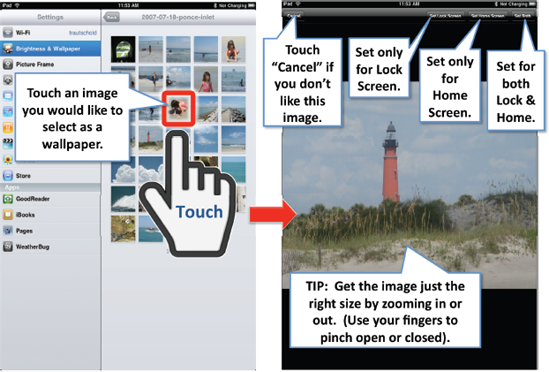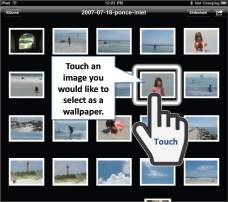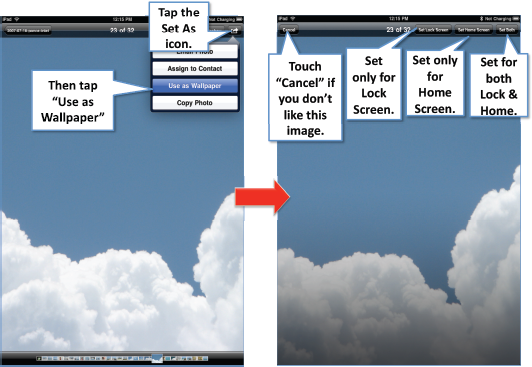There are actually two screens you can personalize on your iPad by changing the wallpaper.
The first is the Lock Screen, which appears when you first turn on your iPad, or wake it up. The wallpaper for this screen image is shown behind the Slide to Unlock slider bar.
The next one is the Home Screen. The wallpaper for this is shown behind the icons.
You can use the wallpaper pictures that come with the iPad or you can use your own images.
|
You may want the wallpaper for your Lock Screen to be less personal than your Home Screen wallpaper. For example, you might choose to put a generic landscape image on your Lock Screen and a picture of a loved one on your Home Screen.
|
|
There are a couple of ways to change the wallpaper on the iPad. The first way is very straightforward.
1. Changing Wallpaper from your Settings
Touch the Settings icon, then touch the Brightness & Wallpaper tab in the left-hand column. The settings for brightness and wallpaper will appear in the right-hand column.
To begin selecting wallpaper, touch the images of your currently selected wallpaper under Wallpaper on the right side of the screen, as shown in Figure 1.

On the right side of the screen (Figure 1, right image), you'll see some albums or image folders. You have some choices:
Tap the Wallpaper tab at the top to see all the preloaded wallpaper pictures for the iPad.
Tap the Saved Photos album, which contains any images you've saved from the Web, from screenshots (which you take by pressing and hold the Home button and Power/Sleep key) or even from wallpaper apps.
Tap any of the albums displayed below Saved Photos. These additional albums will be visible only if you have synced photos from iTunes.
Once you tap any of the albums, you'll see all the images within that album, as in Figure 2.
Tap any of the images in the album to see it on the full screen.
When previewing the image on the full screen, you can:
Zoom in or out by pinching your fingers open or closed.
Tap the Cancel button to return to the album if you don't like the image.
Tap the Set Lock Screen button to set the image only for your Lock Screen.
Tap the Set Home Screen button to set the image only for your Home Screen.
Tap the Set Both button to set the image for both your Lock and Home Screens.

2. Change Wallpaper from any Picture
The second way to change your wallpaper is to view any picture in your Photos collection and select it as your wallpaper.
Tap the Photos icon to get started.
Touch the photo album you want to look through to find your wallpaper.
When you find a photo you want to use, touch it and it will open on your screen.

After you preview the image, as in Figure 3, tap the Set as icon  on the top right corner of the screen and select Use As Wallpaper. Zoom in or out as you desire and then set as either your Lock or Home Screen or both, as described above.
on the top right corner of the screen and select Use As Wallpaper. Zoom in or out as you desire and then set as either your Lock or Home Screen or both, as described above.

If you decide you'd rather use a different picture, choose Cancel and pick a different one.